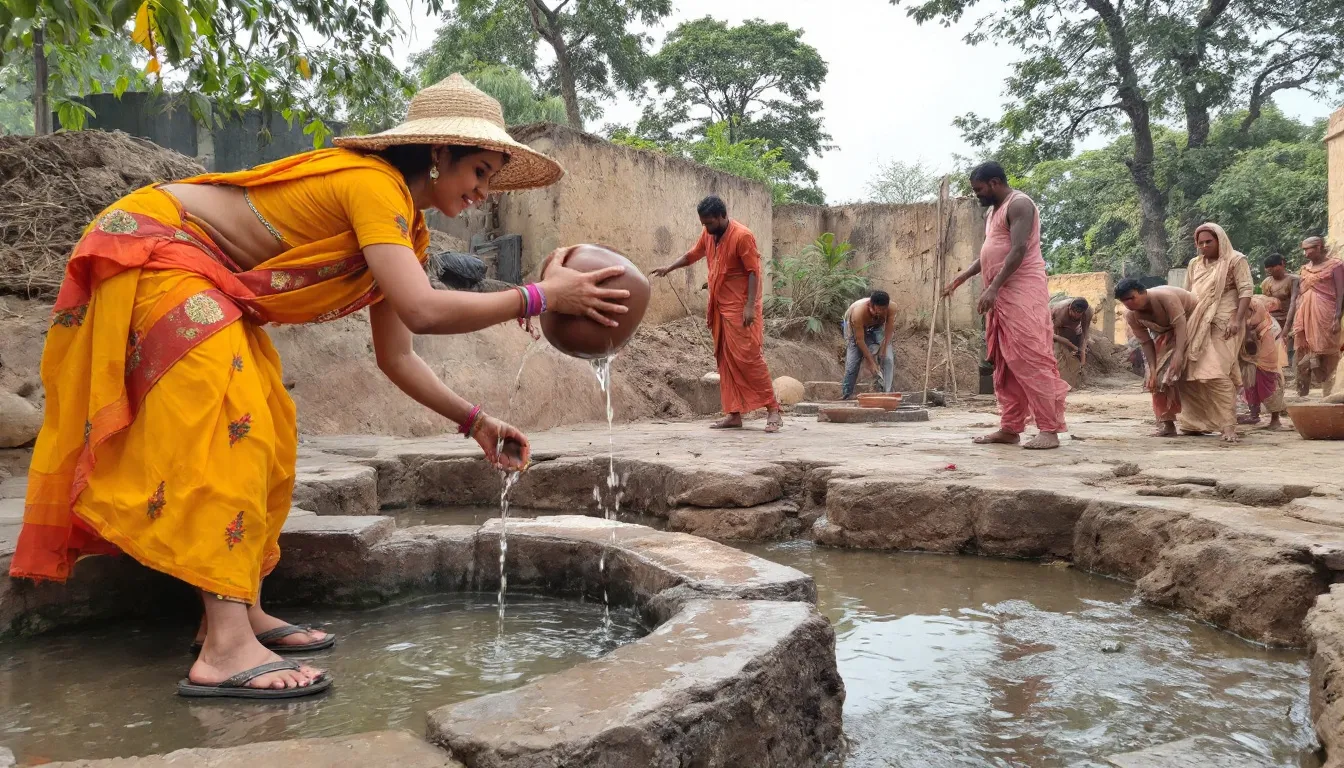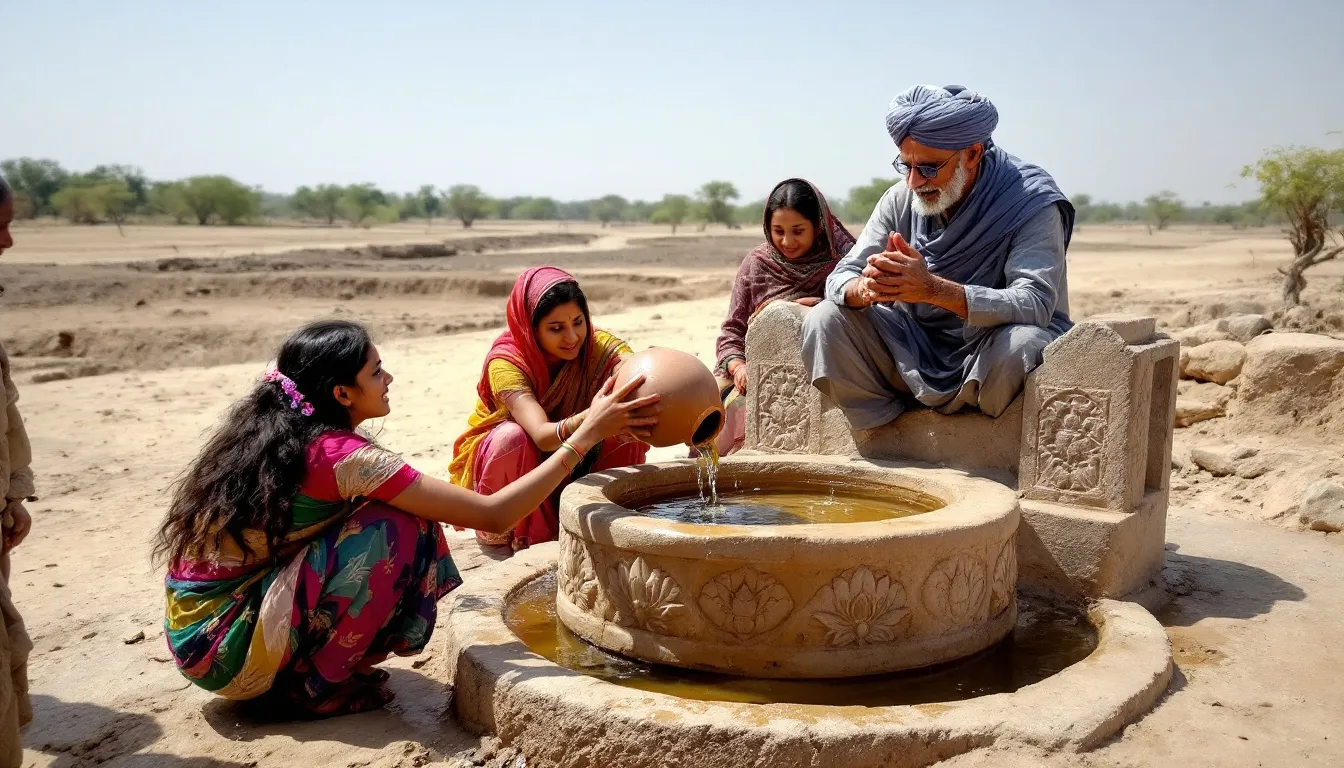
India’s diverse climatic zones have fostered a rich legacy of traditional water conservation techniques, especially in regions prone to drought. These indigenous methods, developed over centuries, have been instrumental in ensuring water availability, supporting agriculture, and sustaining local communities. In the face of modern challenges like climate change and water scarcity, revisiting and revitalizing these age-old practices offers valuable insights for sustainable water management. For example, the historic stepwell of Chand Bawri is a captivating instance of inverted architecture that showcases ancient techniques for water conservation.
Introduction to Drought-Prone Regions
Drought-prone regions in India are grappling with severe water scarcity, which significantly impacts the livelihoods of local communities and the overall food security of the country. These areas require sustainable water management practices, including traditional water harvesting structures and rainwater harvesting, to ensure water availability throughout the year.
Integrating traditional approaches with modern technology can help mitigate the effects of drought and promote sustainable agriculture. Groundwater recharge is a critical aspect of water conservation in these regions, and traditional water systems can play a vital role in recharging groundwater levels. The construction and restoration of traditional water bodies, such as ponds and lakes, can help store water during the rainy season and provide a reliable water source during times of drought.
Climate change has exacerbated the drought situation in many parts of India, making it essential to adopt sustainable water management practices to ensure water availability and food security. Small tanks and dams can be constructed to store rainwater and provide irrigation facilities to farmers, helping to improve agricultural productivity and reduce the impact of drought.
Organizations like the Aga Khan Trust have been involved in efforts to restore traditional water harvesting structures and promote sustainable water management practices in drought-prone regions. Clean water is essential for human consumption, and traditional water systems can provide a reliable source of clean water for local communities. The restoration of traditional water bodies can also help improve water quality, reduce pollution, and promote biodiversity in drought-prone regions.
Historical Context of Traditional Water Systems
Traditional water systems have been an integral part of India’s culture and history. Ancient civilizations, such as the Indus Valley, showcased advanced water management through structures like reservoirs and drainage systems. Over time, various regions developed unique water harvesting structures tailored to their specific geographical and climatic conditions. These systems were designed to carry water efficiently, mitigating the challenges of water scarcity in drought-prone regions.
For instance, the stepwells or baolis in Gujarat and Rajasthan are architectural marvels designed to access groundwater during dry periods. Similarly, tanks and ponds in South India, like those in Tamil Nadu and Karnataka, served both religious and practical purposes, aiding in irrigation and groundwater recharge. These structures not only provided water for drinking but also became centers for social and cultural activities, emphasizing their significance in daily life. The impact of these water resources on the lives of local communities is profound, supporting their livelihoods, traditional practices, and community sustainability.
Traditional Water Harvesting Structures
1. Johads (Rajasthan)
Johads are earthen check dams constructed to capture and store rainwater, facilitating groundwater recharge. Predominantly found in Rajasthan, these structures have been revived in recent decades, notably by the efforts of NGOs like Tarun Bharat Sangh, leading to increased water availability and agricultural productivity in the region. These initiatives have significantly involved villagers, empowering local communities by providing them access to reliable water sources and enhancing their quality of life.
2. Khadins (Western Rajasthan)
A Khadin is an ingenious construction designed to harvest surface runoff water for agriculture. It involves building a long earthen embankment across the lower hill slopes, allowing water to collect and seep into the soil, making it suitable for cultivation.
3. Baolis and Stepwells (Gujarat, Rajasthan)
These are deep well-like structures with steps leading down to the water, providing water access even during periods of low water levels. Beyond their functional use, many baolis are architectural masterpieces, reflecting the artistry of their time. These ancient stepwells also serve as effective water storage systems, helping recharge groundwater and address modern water crises.
4. Ahar-Pynes (Bihar)
This traditional system involves diversion channels (pynes) that direct water to embanked reservoirs (ahars). It’s an effective method for floodwater harvesting and irrigation in the alluvial plains of Bihar.
5. Zabo System (Nagaland)
The Zabo system, also known as Ruza, is a unique water management practice from Nagaland. It integrates forest conservation, agriculture, and water harvesting, ensuring sustainable water supply and soil fertility.
Benefits of Traditional Approaches
Traditional water harvesting structures have been used for centuries in India to conserve and manage water, and they continue to play a vital role in sustainable water management. These structures are often constructed using local materials and traditional practices, making them an integral part of the local culture and community.
Traditional approaches to water conservation can help reduce evaporation, contribute to groundwater recharge, and maintain water quality. The use of traditional water harvesting structures can also promote biodiversity, as they often provide habitat for various plant and animal species. In addition to their practical benefits, traditional water harvesting structures can also serve as a connection to the past and help preserve cultural heritage.
The maintenance and restoration of traditional water bodies can provide employment opportunities for local communities and help promote sustainable livelihoods. Traditional water harvesting structures can be used in conjunction with modern technology to create innovative solutions to water management challenges. The state of Uttar Pradesh has implemented various initiatives to promote traditional water harvesting structures and sustainable water management practices.
The use of traditional approaches to water conservation can help address the challenges posed by climate change and promote sustainable development in drought-prone regions. By adopting traditional water harvesting structures and sustainable water management practices, India can reduce its reliance on groundwater and promote more efficient use of water resources, ultimately contributing to a more water-secure future.
Community-Based Initiatives
Local communities have always played a pivotal role in water conservation. The diverse population, including Jats, Gujars, and Meos, contributes significantly to the rich socio-cultural fabric of the Govardhan region. Their intimate knowledge of the land and collective efforts have led to the successful implementation and maintenance of various water harvesting structures, harmoniously integrating with the natural landscape.
Case Study: Jakhni Village, Uttar Pradesh
In Banda district, the residents of Jakhni village undertook the revival of traditional ponds and wells, leading to a significant rise in the groundwater table. Their model inspired the development of over 1,000 “water villages” across India, emphasizing the power of community-driven initiatives. These water bodies are used for various communal purposes, including washing, which illustrates their versatility in addressing local needs.
Role of NGOs
Organizations like the Aga Khan Rural Support Programme (AKRSP) have been instrumental in promoting community-based water management. By providing technical support and facilitating community participation, they have enhanced water availability and agricultural productivity in several regions.
Climate Change and Its Impact

Climate change has exacerbated water scarcity in many parts of India. Erratic rainfall patterns, prolonged droughts, and increased evaporation rates have strained traditional water sources.
-
Changing Rainfall Patterns: Regions that once received consistent rainfall now face unpredictability, affecting the replenishment of water bodies.
-
Increased Evaporation: Rising temperatures lead to higher evaporation rates, reducing water availability in tanks and ponds.
In this context, traditional water conservation techniques offer resilience. Structures like johads and khadins not only store water but also recharge groundwater, providing a buffer against climatic uncertainties.
Modern Applications and Architectural Perspectives
Integrating traditional water harvesting structures into modern architecture from an architectural perspective offers sustainable solutions for urban water management.
Urban Rainwater Harvesting
Cities like Chennai and Bengaluru have adopted rooftop rainwater harvesting systems, drawing inspiration from traditional practices. These systems reduce dependency on external water sources and mitigate urban flooding.
Architectural Revivals
Architects are now incorporating elements like stepwells and tanks into contemporary designs, blending aesthetics with functionality. Such integrations not only conserve water but also pay homage to India’s rich architectural heritage.
These architectural revivals highlight the importance of effective water management strategies that can be applied around the world to address global challenges such as climate change, poverty reduction, and food security.
Conclusion and Future Directions

Traditional water conservation techniques from drought-prone Indian regions offer valuable lessons in sustainable water management. Their relevance has only increased in the face of modern challenges like climate change and urbanization.
Future Strategies:
-
Policy Integration: Incorporate traditional methods into national water policies and urban planning.
-
Community Engagement: Empower local communities through training and resources to manage and maintain water structures.
-
Research and Documentation: Systematically document traditional practices to preserve knowledge and facilitate wider adoption.
By blending traditional wisdom with modern innovations, India can pave the way for a water-secure future, ensuring the well-being of its people and the sustainability of its ecosystems.

Good https://is.gd/N1ikS2
OeVIJ mwr Sjep